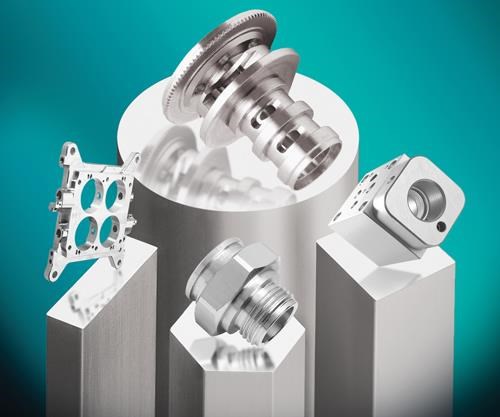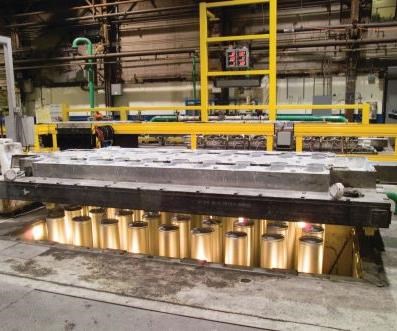How Metallurgical Structure Affects the Machinability of Aluminum
Advancements in grain structure consistency and mechanical properties help to make this extremely machinable metal suitable for an ever growing range of applications.
The term “machinability” refers to the ease with which a metal can be machined to an acceptable surface finish. But maximizing machinability is a complex, sometimes trial-and-error process that is influenced by a number of factors that often must be fine-tuned.
Fortunately, compared with other construction materials, aluminum is relatively easy to machine. It responds well to most fabrication methods, including milling, drilling, cutting, punching and bending. Despite the “machine friendliness” of aluminum, though, machine shops have a number of specific concerns when it comes to working with this material, including long, stringy chips, chips wrapping on parts, machined surface finish, rough thread finish, dimensions, diameter to fit in collets, straightness, good tool life, and high production rates.
The metallurgical field is making advances every day that are producing better results with materials such as aluminum in machine shops around the world. At Sapa Extrusions North America, for instance, the goal is to provide machine shops with product that is unmatched in consistency and tolerance control.
Aluminum Machinability
Three factors affect the machinability of aluminum. The first factor is the machining process, which includes the type of equipment, the cutting tools, cutting speeds, feed rates and lubricants. The second factor involves the material—specifically, the particular alloy and temper of the aluminum, its microstructure, and how uniform its mechanical properties are. The third factor is the material processing, which involves the alloy chemistry and heat treatment, the extrusion process controls, the reduction ratio and die design, and whether direct or indirect presses were used in extruding the aluminum.
Machinability Ratings
Machinability ratings for aluminum are based on chipping characteristics. Because of the volume of chips created while machining aluminum, their form takes on great significance. Generally, the goal in machining aluminum is to generate short, tight chips that do not interfere with tooling or mar the surface of the part. Machinability ratings for aluminum specify expectations for chips and surface finish:
- A-rated: Very small chips, excellent surface finish
- B-rated: Curled or easily broken chips, good to excellent finish
- C-rated: Continuous chips, good surface finish
- D-rated: Continuous chips, satisfactory finish
- E-rated: Long, continuous chips, difficult to maintain finish
An array of chip forms can be created; depending on the aluminum alloy selected, almost all forms of chips can be produced. As a general rule, the harder and stronger the aluminum alloy, the shorter the chips. Because of that, pure aluminum and soft wrought alloys produce extremely long chips. Special corrective measures, such as adding chipbreakers to the tools, are essential with these materials.
High strength wrought alloys present no issues in terms of chip form, and hypoeutectic casting alloys form short-coiled and spiral chips, which are easy to remove. Additionally, eutectic casting alloys tend to produce longer chips, while hypereutectic casting alloys result in short, fragmented chips, which can be hard to remove.
Alloys that are best suited to machining contain alloying elements with low melting temperatures, which help in the formation of the preferred, shorter chips.
Enhancing Metallurgy for Machining
One of the great advances in extrusion metallurgy has been the advent of the indirect extrusion process. The most common type of extrusion in the aluminum industry occurs on a direct press, a process in which a ram pushes a billet through the container and the metal flows through a die. Direct presses can produce larger and wider shapes than can an indirect press. But because the direct extrusion process generates tremendous friction and heat between the billet and the container wall, pressure and temperature vary as the billet extrudes. The result is inconsistent grain structure and compromised metallurgical properties in the finished product.
An indirect press, on the other hand, pushes the container, billet and ram together over the die. Extrusions of harder alloys and thinner shapes are created using a lower tonnage press. Because there is less frictional heat and more constancy in pressure and temperature, the extruded product is more consistent, both from a metallurgical as well as a dimensional standpoint.
Sapa operates an extensive line of presses with indirect extrusion technology. The company is able to supply the production industry with machine-grade rod, bar and hex products that have consistent grain structure, tight dimensions and high mechanical properties. For machining applications, the company’s Acc-U-Line products can deliver rod as large as 12.125-inch diameter; square bar as thick as 9 inches; rectangular bar as wide as 19.6 inches; and alloy options in 6061, 6042, 6082 and 6262.
Backed by independent testing and complemented by in-house billet casting capabilities, Sapa can offer special chemistries that are more precise than, or customized from, Aluminum Association standards. Coupled with an in-house, heat treating operation, Sapa can produce products with special tempers to enhance formability and machinability.
Alloy Options for Machining
The aluminum industry uses a four-digit index system for the designation of wrought aluminum alloys. The first digit indicates the major elements used, along with aluminum, in the alloy. Alloys in the 6xxx series—among the most widely used in production machining shops—contain magnesium and silicon. The most common alloys used in machine production are 6061, 6042, 6082 and 6262. Each has particular benefits for specific machining needs.
Alloy 6061 is one of the most widely used in the 6000 series, and for good reason. The least expensive and most versatile of the heat treatable aluminum alloys, 6061, offers a range of good mechanical properties along with good corrosion resistance. It is a candidate for most machining techniques. It is popular for medium to high strength requirements and has good toughness characteristics.
For screw machine applications, alloy 6061 has adequate machinability characteristics in the heat-treated T6/T6511 condition. Chips from turning and drilling can be difficult to break in the T6/T6511 temper condition. For that reason, chipbreakers and special machining techniques, such as peck drilling, should be considered in order to improve chip formation. The alloy is most commonly used for transportation components, machinery and equipment, recreation products, and consumer durables.
Alloy 6082, which is very common in Europe and is gaining popularity in the U.S., offers similar—though not identical—physical characteristics to the 6061 alloy, along with slightly higher mechanical properties in the -T6 condition. This alloy is a good choice for structural applications, including rod, bar, tube and profiles. It offers good finishing characteristics and responds well to anodizing. The most common anodizing methods include clear, clear and color dye, and hard coat.
The alloy also offers good welding and brazing capabilities, corrosion resistance, formability and machinability. When bending or forming 6082 alloy, the -0 or -T4 temper should be used. For machining applications, 6082 provides good machinability in the -T5 or -T6 tempers. Chips may be difficult to break, so chipbreakers or special machining techniques such as peck drilling should be used to improve chip formation. For certain thin-wall sections, -T6 temper may not be available because of alloy quenching limitations.
Various commercial joining methods, such as welding or brazing, can be easily applied to 6082 alloy. However, since it is a heat treatable alloy, strength will be reduced in the weld region. For machining applications, alloy 6082 is available in many rod, bar and hex sizes.
Typical applications include rod and bar, machining stock, structural profiles, seamless tubing, and custom profiles.
Alloy 6042 is a new aluminum alloy that offers improved machinability and reduced lead levels to comply with RoHS and ELV recycling requirements. It offers good machinability characteristics similar to 6262. In the heat-treated -T5, -T5511 temper condition, 6042 typically produces curled and broken chips and smooth machined surface. In certain applications, the use of chipbreakers or special machining techniques, such as peck drilling, can further improve chip condition.
Typical applications for alloy 6042 include electrical connectors and screws, brake components, pneumatic manifolds and valve blocks, air conditioning components, hydraulic manifolds and valve blocks, and hardware and fasteners.
Alloy 6262 is probably familiar to most machine shops, as it is the alloy of choice for applications requiring improved machinability. This alloy is one of the few developed specifically for machining applications, including screw machine and CNC machine products.
Sapa offers the alloy with a variety of standard and special tempers, and to further enhance its machinability, a unique chemical analysis has been developed that conforms to industry standards. Sapa produces extruded 6262-T6 and -T6511, which are listed in ASTM B 221 and ASTM B 241 specifications. For machining applications, alloy 6262 is available in many rod, bar and hex sizes.
For screw machine applications, alloy 6262 has good machinability characteristics in the heat treated -T6, and -T6511 condition. Generally, the alloy produces curled and broken chips while machining. However, in certain applications, the use of chipbreakers or special machining techniques, such as peck drilling, can further improve chip formation.
This alloy has excellent corrosion resistance to atmospheric conditions and good corrosion resistance to sea water. This alloy also offers good finishing characteristics and responds well to all common anodizing methods, enhancing resistance to corrosion and wear. The most common anodizing methods are clear, clear and color dye, and hard coat.
Joining characteristics for welding and brazing of alloy 6262 are significantly improved over alloy 2011, although they are not as good as alloy 6061. Since 6262 is a heat treatable alloy, strength in its -T6 condition can be reduced by heat from welding or brazing. Selection of an appropriate filler alloy will depend on the desired weld characteristics.
Typical applications for alloy 6262 include automotive and truck brake components, air conditioning components, manifolds, hydraulic valve blocks, electrical and cable components, and hardware and fasteners.
Other Factors for Improving Machinability
In addition to excellent product, machine shops can enhance machinability by paying close attention to tools and processing. Aluminum is most successfully machined with tools made of tool steel, high-speed steel, cemented carbides and diamond. Ceramic cutting materials are not recommended. Because of its chemical affinity for aluminum, ceramic will not deliver an acceptable operating life. Similarly, the synthetic cutting materials that are used successfully for machining steel are not a good choice for aluminum.
After the proper tools have been selected, other important considerations will also contribute to improved machinability:
- Tools and toolholders must be rigid.
- Tools should have a finely ground edge to minimize buildup.
- Cutting edges should be kept sharp at all times.
- Chips must be directed away from the workpiece or broken up by a chipbreaker to prevent part damage.
- Productivity can be improved by increasing speeds while maintaining feed rates and cutting at moderate depths.
- Excessive cutting pressures should be avoided unless the workpiece is adequately supported.
- Lower feed rates should be used on thin-walled parts.
- Recommended rake angles should be used to reduce cutting forces, thus producing thinner chips and reducing metal buildup.
- Coolant feed drills and high-pressure coolant feed systems should be used.
Rake angle, feed rates, drilling recommendations and lubricant choices are also important to consider when machining aluminum. Extruders can supply detailed recommendations for product that is selected.
One Final Tool
When facing machining challenges, production machine shops should not underestimate the value of technical support that an extruder is happy to provide. Sapa runs a Profile Academy that customers are welcome to attend to expand their knowledge of extruded products and how they behave in machining applications. Extruders also provide sales support via phone or email, which can save a shop time and money.
Aluminum remains one of the most machinable metals available. With its reputation for strength and lightness, it continues to be a preferred metal by customers in a range of industries. Extruders and machine production shops enjoy a strong partnership. The extrusion industry remains committed to supplying machine shops with product that features consistent grain structure, tighter dimensions and higher mechanical properties.
— Hydro
Related Content
How Small Machine Shops Can Fight Supply Chain Problems
Supply chain disruptions are still presenting challenges in manufacturing. This article examines the effects on aerospace, automotive and medical industries. It also covers ways that machine shops can be successful securing work despite the challenges created by the supply chain.
Read MoreThe Value of Mass Finishing, Shot Blasting for Aerospace and Medical Applications
The choice between mass finishing and shot blasting for CNC-machined parts depends on the specific requirements of the application.
Read MoreA Small CNC Machine Shop’s Journey to CMMC
Achieving Cybersecurity Maturity Model Certification (CMMC) — soon to be required to do work for the U.S. government — takes time and money. This 10-person shop takes us through some of the challenges it has faced and lessons it has learned on its CMMC voyage.
Read MoreJR Machine Launches Expansion Strategy, Hires New CEO
An investment from Schneider Resources Holding positions JR Machine to grow in emerging markets such space exploration and green energy.
Read MoreRead Next
Consistency with Indirect Extrusion
A return to basics, paired with extensive research, proved instrumental in the enhancements of this aluminum rod and bar manufacturer’s product line.
Read MoreA Tooling Workshop Worth a Visit
Marubeni Citizen-Cincom’s tooling and accessory workshop offers a chance to learn more about ancillary devices that can boost machining efficiency and capability.
Read MoreDo You Have Single Points of Failure?
Plans need to be in place before a catastrophic event occurs.
Read More

























